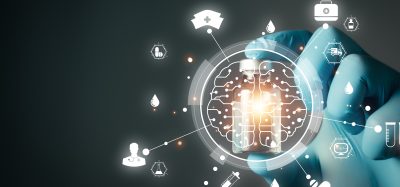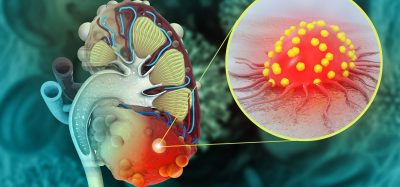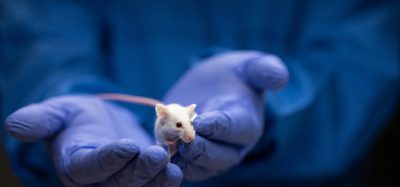Hypoxia and EUDAL: the hidden drivers of oral cancer survival
Posted: 2 October 2025 | Drug Target Review | No comments yet
A newly discovered RNA molecule, EUDAL, helps oral cancers survive chemotherapy by keeping a key growth protein permanently active. Researchers say targeting EUDAL could predict resistance and improve treatment outcomes.
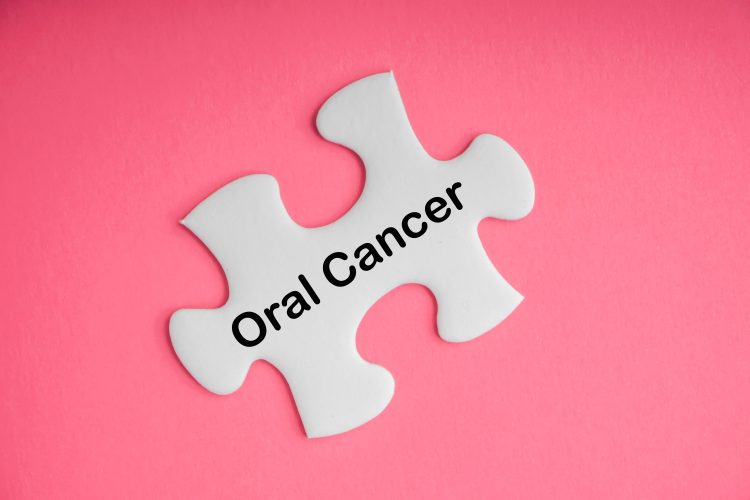

Oral cancer is one of the most common head and neck cancers worldwide, with hundreds of thousands of new cases diagnosed each year. Yet despite advancements in surgery, radiotherapy and chemotherapy, survival rates remain poor. A major challenge is that tumours rapidly adapt and develop resistance to drugs that previously proved effective against them.
A key factor behind this resistance is hypoxia – a shortage of oxygen that develops inside tumours as they grow. Hypoxia not only promotes aggressive cancer behaviour but also reduces the effectiveness of treatments. Scientists have long theorised that hypoxia interacts with critical growth pathways in cancer cells, but the exact mechanisms remained unclear.
Now, a new study has revealed an unexpected mechanism. Led by Professor Zhiyuan Zhang and Associate Professor Qin Xu at the Ninth People’s Hospital and the Shanghai Jiao Tong University School of Medicine, the research shows that hypoxia can directly activate the epidermal growth factor receptor (EGFR) – a protein normally switched on by external signals to drive cell growth and survival. In this case, EGFR becomes active without its usual triggers.
Biomarkers are redefining how precision therapies are discovered, validated and delivered.
This exclusive expert-led report reveals how leading teams are using biomarker science to drive faster insights, cleaner data and more targeted treatments – from discovery to diagnostics.
Inside the report:
- How leading organisations are reshaping strategy with biomarker-led approaches
- Better tools for real-time decision-making – turning complex data into faster insights
- Global standardisation and assay sensitivity – what it takes to scale across networks
Discover how biomarker science is addressing the biggest hurdles in drug discovery, translational research and precision medicine – access your free copy today
Discovery of a novel RNA molecule
The team identified a previously unknown long noncoding RNA (lncRNA) EGFR ubiquitination- and degradation-associated lncRNA (EUDAL). Unlike messenger RNAs that code for proteins, lncRNAs regulate other molecules inside cells. Normally, EGFR is controlled by a cellular ‘tagging’ system, where helper proteins such as c-Cbl/Grb2 attach molecular labels signalling it for disposal. EUDAL blocks this step by binding to EGFR – preventing its breakdown. As a result, EGFR remains permanently active, triggering downstream pathways (STAT3/BNIP3) and promoting autophagy – a recycling mechanism that cancer cells exploit to survive chemotherapy.
Unlike messenger RNAs that code for proteins, lncRNAs regulate other molecules inside cells.
“We were surprised to discover that oxygen shortage alone was enough to switch on EGFR in oral cancer cells,” says Professor Zhang. “This noncanonical activation gives tumours a survival advantage and helps explain why many patients do not respond to chemotherapy.”
EUDAL confers chemotherapy resistance
The researchers tested the role of EUDAL in cell and animal models. Oral cancer cells with high EUDAL levels resisted a standard chemotherapy drug, called cisplatin, but blocking EUDAL restored drug sensitivity.
Animal studies mirrored these results as tumours rich in EUDAL continued to grow after cisplatin therapy, but when combined with inhibitors of STAT3 or autophagy, tumour size reduced significantly.
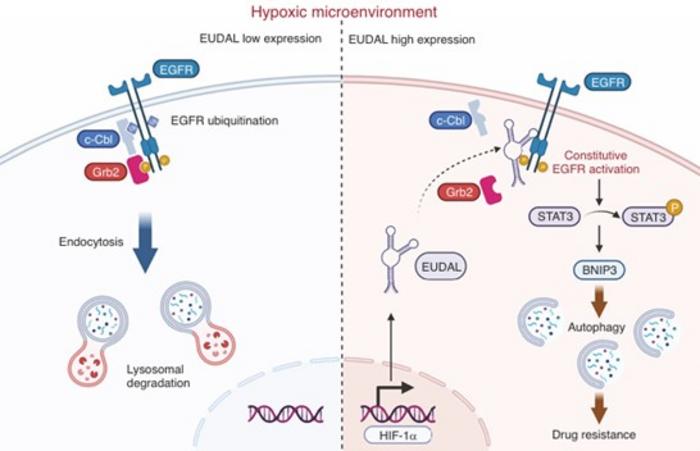

In normal conditions (left), EGFR is tagged by c-Cbl/Grb2 for breakdown inside lysosomes. In hypoxia (right), the RNA molecule EUDAL prevents this process, keeping EGFR permanently active. This activates the STAT3/BNIP3 pathway, triggering autophagy and allowing oral cancer cells to resist chemotherapy. Credit:Prof. Zhiyuan Zhang and Dr. Qin Xu from Shanghai Jiao Tong University, School of Medicine, Shanghai, China
Patient tumour analysis supports findings
Tumour samples from patients undergoing platinum-based chemotherapy showed that those with higher levels of EUDAL, active EGFR and STAT3 were more likely to respond poorly to treatment. Patients with lower levels responded better.
“Our results suggest that EUDAL is not just a marker but a driver of resistance,” says Dr Xu. “In practice, measuring EUDAL levels could help predict which patients are unlikely to benefit from standard chemotherapy, allowing doctors to choose alternative or combination strategies.”
Implications for cancer treatment
This new study changes our understanding of EGFR biology. Previously, it was widely thought that EGFR activation depended on mutations or external growth factors. This research shows that the tumour microenvironment – specifically oxygen shortage – can fuel EGFR activity through a novel RNA-based mechanism.
Overall, EUDAL emerges as both a biomarker of poor treatment response and a potential therapeutic target. Drugs that block EUDAL could one day be combined with chemotherapy to overcome resistance and offer patients more effective treatment options.
Related topics
Biomarkers, Cancer research, Chemotherapy, Drug Discovery, Drug Discovery Processes, Drug Targets, Oncology, RNAs, Translational Science
Related conditions
Head and Neck cancer
Related organisations
Ninth People’s Hospital, the Shanghai Jiao Tong University School of Medicine



